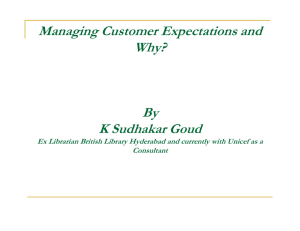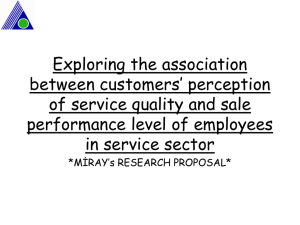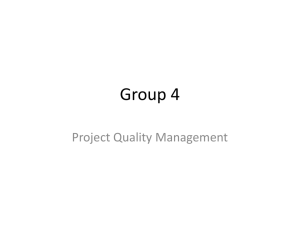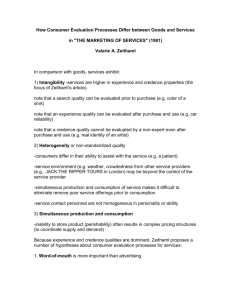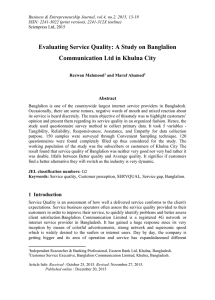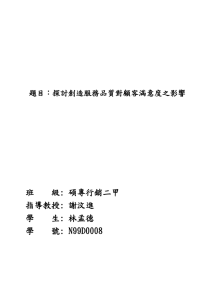Document 13310638
advertisement
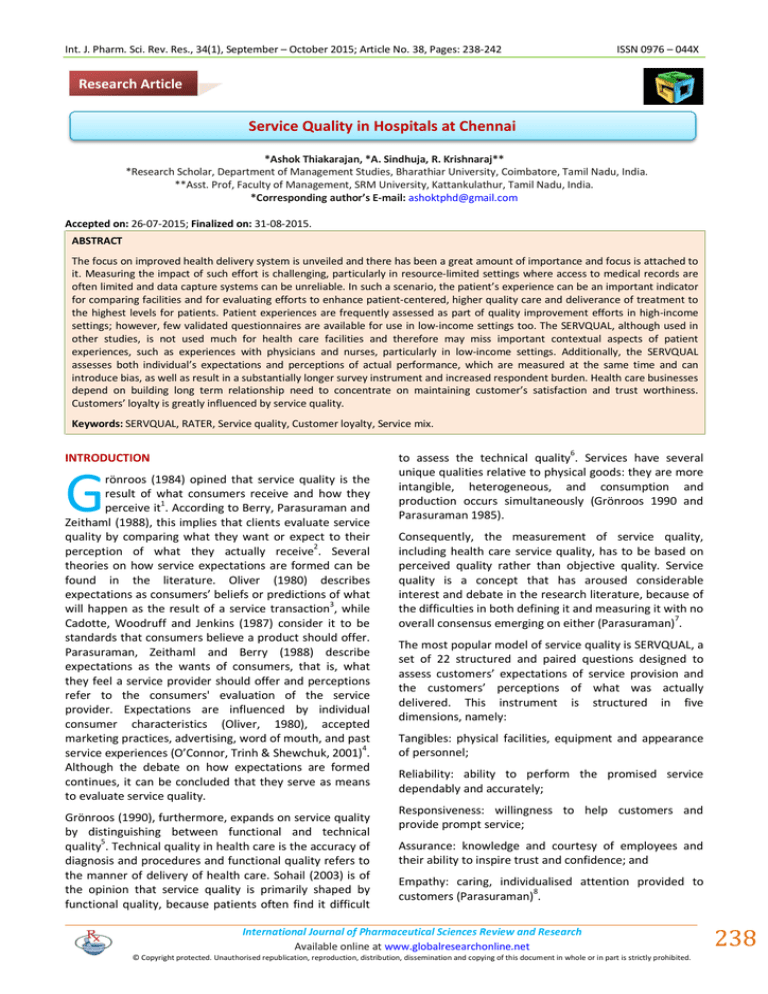
Int. J. Pharm. Sci. Rev. Res., 34(1), September – October 2015; Article No. 38, Pages: 238-242 ISSN 0976 – 044X Research Article Service Quality in Hospitals at Chennai *Ashok Thiakarajan, *A. Sindhuja, R. Krishnaraj** *Research Scholar, Department of Management Studies, Bharathiar University, Coimbatore, Tamil Nadu, India. **Asst. Prof, Faculty of Management, SRM University, Kattankulathur, Tamil Nadu, India. *Corresponding author’s E-mail: ashoktphd@gmail.com Accepted on: 26-07-2015; Finalized on: 31-08-2015. ABSTRACT The focus on improved health delivery system is unveiled and there has been a great amount of importance and focus is attached to it. Measuring the impact of such effort is challenging, particularly in resource-limited settings where access to medical records are often limited and data capture systems can be unreliable. In such a scenario, the patient’s experience can be an important indicator for comparing facilities and for evaluating efforts to enhance patient-centered, higher quality care and deliverance of treatment to the highest levels for patients. Patient experiences are frequently assessed as part of quality improvement efforts in high-income settings; however, few validated questionnaires are available for use in low-income settings too. The SERVQUAL, although used in other studies, is not used much for health care facilities and therefore may miss important contextual aspects of patient experiences, such as experiences with physicians and nurses, particularly in low-income settings. Additionally, the SERVQUAL assesses both individual’s expectations and perceptions of actual performance, which are measured at the same time and can introduce bias, as well as result in a substantially longer survey instrument and increased respondent burden. Health care businesses depend on building long term relationship need to concentrate on maintaining customer’s satisfaction and trust worthiness. Customers’ loyalty is greatly influenced by service quality. Keywords: SERVQUAL, RATER, Service quality, Customer loyalty, Service mix. INTRODUCTION G rönroos (1984) opined that service quality is the result of what consumers receive and how they perceive it1. According to Berry, Parasuraman and Zeithaml (1988), this implies that clients evaluate service quality by comparing what they want or expect to their perception of what they actually receive2. Several theories on how service expectations are formed can be found in the literature. Oliver (1980) describes expectations as consumers’ beliefs or predictions of what 3 will happen as the result of a service transaction , while Cadotte, Woodruff and Jenkins (1987) consider it to be standards that consumers believe a product should offer. Parasuraman, Zeithaml and Berry (1988) describe expectations as the wants of consumers, that is, what they feel a service provider should offer and perceptions refer to the consumers' evaluation of the service provider. Expectations are influenced by individual consumer characteristics (Oliver, 1980), accepted marketing practices, advertising, word of mouth, and past 4 service experiences (O’Connor, Trinh & Shewchuk, 2001) . Although the debate on how expectations are formed continues, it can be concluded that they serve as means to evaluate service quality. Grönroos (1990), furthermore, expands on service quality by distinguishing between functional and technical quality5. Technical quality in health care is the accuracy of diagnosis and procedures and functional quality refers to the manner of delivery of health care. Sohail (2003) is of the opinion that service quality is primarily shaped by functional quality, because patients often find it difficult to assess the technical quality6. Services have several unique qualities relative to physical goods: they are more intangible, heterogeneous, and consumption and production occurs simultaneously (Grönroos 1990 and Parasuraman 1985). Consequently, the measurement of service quality, including health care service quality, has to be based on perceived quality rather than objective quality. Service quality is a concept that has aroused considerable interest and debate in the research literature, because of the difficulties in both defining it and measuring it with no 7 overall consensus emerging on either (Parasuraman) . The most popular model of service quality is SERVQUAL, a set of 22 structured and paired questions designed to assess customers’ expectations of service provision and the customers’ perceptions of what was actually delivered. This instrument is structured in five dimensions, namely: Tangibles: physical facilities, equipment and appearance of personnel; Reliability: ability to perform the promised service dependably and accurately; Responsiveness: willingness to help customers and provide prompt service; Assurance: knowledge and courtesy of employees and their ability to inspire trust and confidence; and Empathy: caring, individualised attention provided to customers (Parasuraman)8. International Journal of Pharmaceutical Sciences Review and Research Available online at www.globalresearchonline.net © Copyright protected. Unauthorised republication, reproduction, distribution, dissemination and copying of this document in whole or in part is strictly prohibited. 238 © Copyright pro Int. J. Pharm. Sci. Rev. Res., 34(1), September – October 2015; Article No. 38, Pages: 238-242 ISSN 0976 – 044X Although SERVQUAL has been criticised for its conceptualisation, generalisability and dimensionality (Babakus & Boller, 1992; Cronin & Taylor, 19929; Lam & Woo, 1997 and Buttle, 1996), it is widely used by academics and practitioners to measure service quality (Wong, 2002; Youssef, Nel & Bovaird, 1996; Sewel, 1997 and Jabnoun & Chaker, 2003). Numerous studies on service quality in the health care industry utilised and adopted the SERVQUAL instrument with diverse findings on the dimensions identified (Butler, Oswald & Turner, 1996)10, as well as the relative importance of the dimensions of service quality (Wong, 2002; Youssef, Nel & Bovaird, 1996; Sewel, 1997 and Jabnoun & Chaker, 2003)11. The assurance perceived by customers is an important dimension of service quality in any industry 12 (Zeithaml but even more so in the health care industry where customers associate quality with perceptions of human factors (Butler, Oswald, Turner, 1996). Assurance is especially critical where trust and confidence in the service provider are crucial (Branssington & Pettit, 2000) and this clearly is also applicable to the health care sector (Van Der Schee, Groenewegen, & Friele, 2006). Assurance and the assessment thereof should clearly be an integral part of health care delivery strategy (Ovretveit, 2004). 1996). Edvardsson argue that a service itself should fulfil the requirements of both internal and external customers and through continuous improvement of the process to achieve productivity and quality excellence. Although tangibility as a service quality dimension is rather simple to manage because people are not really involved, the possible financial constraints in the public health care sector in South Africa should be taken into consideration when it is assessed. In various service quality studies, tangibility has been found to be rather unimportant (Zeithaml). However, Boshoff and Gray (2004) remark that this is not the case in the hospital environment13. Reliability refers to a providers’ ability to perform the promised service dependably and accurately. Perceptions of reliability are also lessened with doctors do not provide correct treatment at the first time (accusation that doctors recommend unnecessary medical tests, irregular supervision of patients by care providers and specialists are unavailable). Patients expect hospital staff to respond promptly when needed. It is the willingness and promptness of responding to the patients. They also expect the experts and required equipment to be available, functional and able to provide quick diagnoses of diseases. MATERIALS AND METHODS Service Quality Parasuraman suggest five-dimension framework of service quality that encompasses tangibles, reliability, responsiveness, assurance and empathy to analyze service quality. Besides, GroEnroos (1990) also argues there are six elements in recognizing the perceived value of customer services namely: Professionalism and Skills - the hospital staff should have the inquisitiveness, skills and knowledge to address the customers’ problem Attitudes and behaviour - the hospital should give solutions to the customer’s problem in a friendly way Accessibility & accommodativeness – the hospital services are simple to access to the demands of the patients in a soothing way Reliability and Trustworthiness -the hospital keeps up the promise in the service delivery The expectation of prices, value and satisfaction would often determine a customer's decisions of a product or service (Scheuing and Christopher, 1993; Stuart and Tax, Wilkerson (1997) adds that the performance of the process characteristics will drive the quality characteristics. Whether a service meets customer expectation is often subjectively judged (Ingram and Daskalakis, 1999). It is thus important for service providers to integrate customer expectations into a quality improvement process, and to consider the cause-and-effect relationship among the results of these measures. The delivery of quality services is not only concerned with the nature of services, but also with the organizational wide commitment and involvement. The determinants of service quality are complicated with the dynamic business environments. The RATER Model was created by Zeithaml, Parasuraman, and Leonard Berry. The RATER refers to service quality dimensions such as Reliability, Assurance, Tangibility, Empathy and Responsiveness. Assurance is the knowledge, skill and courtesy of the service provider that inspire trust and confidence in consumers’ mind. In the health care setting, assurance is reflected by competencies of diagnosis, skills to interpret laboratory report, provide appropriate explanations to queries. Well-trained nurses and other support staffs also play vital roles in providing support to patients’ feelings of assurance and safety. Tangibility is the attribute of being easily detectable with the senses. Appearance (tangibility) of the physical facilities, equipment, personnel and written materials affects patients’ satisfaction. A systematized, ordered and clean appearance of hospital premises, restrooms, equipment, wards, beds and the whole construction or infrastructure can influence patients’ impressions about the hospital. Tangibles are the physicals representations of intangible service that create the image in customer’s mind. Empathy represents the sympathy of service provider. Health care providers’ sympathy and understanding of International Journal of Pharmaceutical Sciences Review and Research Available online at www.globalresearchonline.net © Copyright protected. Unauthorised republication, reproduction, distribution, dissemination and copying of this document in whole or in part is strictly prohibited. 239 © Copyright pro Int. J. Pharm. Sci. Rev. Res., 34(1), September – October 2015; Article No. 38, Pages: 238-242 patients’ problems and needs can greatly influence patient satisfaction. Patients desire the doctors to be observant, attentive and understanding towards them. Similarly patients expect nurses to provide personal care and mental support to them. This reflects service providers’ empathy. Responsiveness is the willingness to help customers and to provide prompt service. If a patient feels alienated, uninformed or uncertain about his / her health status and outcomes, it may affect the healing process. When the nature of the treatment is clearly explained, patients’ queries are responded, and it may alleviate patients’ feelings of uncertainty. Appropriate communication and good rapport can, thus, help convey important information to influence patient satisfaction. ISSN 0976 – 044X customer Expectations are: 1. Motivate the front office or reception staff for understanding on patient expectations 2. Inculcate training methods to listen to the patients needs through feedback analysis 3. Utilise feedback information and inputs into action 4. Establish clear service quality goals that are challenging, realistic, and explicitly designed to meet customer expectations 5. Clearly communicate to employees which tasks have the biggest impact on quality and receive the highest priority. 6. Ensure that employees understand and accept goals and priorities 7. Measure performance and provide regular feedback and reward them suitably to achieve goals The concepts address the place, the products and services offered, the prices charged, and the patient care policies and procedures of the hospitals. 8. Install proper technology and equipment to improve quality and use them to teach the employees about customer expectations, perceptions, and problems Hospital industry patient foot fall and repeat visit 9. Find out the training needs and implement the same periodically In general, the foot falls to hospital i.e. patient arrival or visit has been attributed by various factors like location, profile of doctors and hospital charges and above all patient care and safety. 10. Campaign to be done amongst the hospital staff that patient service the top most priority and all the activities of the hospitals should be focussed towards it. The foot falls are known as Out Patient (OP) and they are treated on outpatient basis. They are converted in to In Patient (IP) when they are admitted in the hospital for a minimum period of 24 hours and above. A questionnaire was administered for pre-test prior to the actual survey to enable the alteration of the measurement scales and the checking for any unclear questions. The delivery gap The pre-test was carried out with 30 patients in three hospitals at Chennai. The lack of foot fall and the failure of management to retain the patient base often occur when the service delivered by employees do not comply with specifications set by management. The hospital sector is particularly susceptible to a big Gap. It is similar to labour intensive there is great mercurially in all human interactions, thus quality of service lies at the door of the providers and the amount of effort they assert in willingness to deliver service excellence. The retainability of the organisation plays a major role in the hospitals as it takes lot of time to train and make the new employee acclimatised to the expected service deliverance of patients. The communication gap The next service quality occurs at a time when the exhibited promises from marketing advertising campaigns, public relations activities and promotions are exaggerated. Customers experience disappointment when the actual service delivery does not meet their expectations based on what they had been led to believe. Directions: Understand the patient needs and learn what Based on the pre-test, necessary modifications were done in the questionnaire and distributed to three hospitals of Chennai. Survey questionnaires were in both in English and Tamil. The questionnaires were used to collect the respondent’s place, details, Socio economic conditions and service quality of the Hospitals. The data were collected from 109 respondents in the three hospitals viz Deepam hospital, Billroth hospital and Andhra Mahila sabha hospital (DDH). Before starting the interview, the purpose of the study was explained and their fullest cooperation is requested to fill up the questionnaire. RESULTS AND DISCUSSION The SERVQUAL gap was calculated. Rating for scale has been assigned from 5 to 1; where 5 is the highest rating and 1 is the lowest. Except Tangibility, other factors registered positive service gap; it confirms the better service than patients’ expectation. This result represents positive service prevailing in these hospitals. International Journal of Pharmaceutical Sciences Review and Research Available online at www.globalresearchonline.net © Copyright protected. Unauthorised republication, reproduction, distribution, dissemination and copying of this document in whole or in part is strictly prohibited. 240 © Copyright pro Int. J. Pharm. Sci. Rev. Res., 34(1), September – October 2015; Article No. 38, Pages: 238-242 ISSN 0976 – 044X Table 1: Foot falls and patient care methodologies Patient Decisions for visiting a hospital Factors that influence the patients satisfaction 1. Preference of Place The reach ability and the type of Facility, equipment and neatness 2. Product / Service considerations The services offered in the hospitals are varied from type of illness covered and the level of care by offering treatment options, OP waiting time, discharge time and nursing/doctors care 3. Hospital charges This is one of the important aspects of consideration for the patient as the charges are different from place to place and type/level of care 4. safety consideration The patient belief and confidence on the facility, doctors and nursing care toward the alleviation of sufferings and safety. Table 2: Gaps in service quality Dimensions Patient expectation (service expectation) Patient Perception (service perception scale) Service gap = (service expectation - Service perception) Tangibles 4.28 4.21 -0.07 Reliability 4.12 4.62 0.50 Responsiveness 4.23 4.60 0.37 Assurance 4.11 4.21 0.10 Empathy 4.09 4.93 0.84 Servqual Gap (Avg.) 4.16 4.51 0.35 The widest positive gaps were reported for dimensions of “Empathy” (0.84) and “Reliability” (0.50). Hospital users’ expectation related to tangibility factors such as physical facilities, equipment and appearance of personnel are more than actual delivery; Hence, the service gap of -0.07 units were reported. The results of the quantitative application of the SERVQUAL model in Chennai hospitals show that the perceptions of patients or customers are higher than the expectation for majority of SERVQUAL factors such as Reliability, Responsiveness, Assurance and Empathy. This proves the existence of a positive SERVQUAL gap. Service gap deficiency reported in any one dimensions may affect the overall opinion towards customer satisfaction. Customers’ awareness has been grown up with reference to health care delivery. Elite community members, foreigners and high class patients prefer Chennai as a choice for their medical treatment. Competition has grown up to greater extent among Chennai Corporate Hospitals. customer retention will lead to the long term goal of customer satisfaction. Monitoring customer loyalty has become an important focus for all managers in the hospitals. Any lacuna in recognising the power of customer satisfaction, especially their emotions, could end up in failure of customer retention and loyalty. Therefore, the greatest challenges in the hospitals are the foot falls and patients but also on identifying customer satisfaction through customer experience individually. Patients may agree that the hospitals are providing high levels of service quality but not necessarily agree that the hospitals and administrators ensure high satisfaction. If hospital prices are perceived to be high, this may still have a negative effect on loyalty. Higher levels of quality are only meaningful to the extent that patients firmly believe that value is being enhanced. Therefore, hospital administrators must carefully execute price competition and understand the value perceived by different market segments. Patient may not choose or opt for the hospital services when the tariff is perceived to be too high, while some became doubtful of quality when tariff is too low. CONCLUSION To summarise the whole thing, understanding the relationship among service quality and loyalty will help administrators to make right decision and prepare their action plan in order to excel in the competitive market environment. The ultimate aim of any hospital is to provide best possible service and there by “create a customer” and by consistently delivering high levels of service quality, The above results of the quantitative application of SERVQUAL instrument shows that this result can provide a useful insight to hospital administrators for the Hence the hospital administrators and staff should understand that the expectations of the patients are high in all aspects. International Journal of Pharmaceutical Sciences Review and Research Available online at www.globalresearchonline.net © Copyright protected. Unauthorised republication, reproduction, distribution, dissemination and copying of this document in whole or in part is strictly prohibited. 241 © Copyright pro Int. J. Pharm. Sci. Rev. Res., 34(1), September – October 2015; Article No. 38, Pages: 238-242 ISSN 0976 – 044X assessment of expectations and perception of patients, with the aim of learning about gaps in individual service quality dimensions. 7. Parasuraman, A., Zeithaml, V.A. and Berry, L.L., “A conceptual model of service quality and its implications for future research”, Journal of Marketing, 49, 1985, 41-50. REFERENCES 8. Parasuraman, A., Zeithaml, V.A. and Berry, L.L., “SERVQUAL: a multiple-item scale for measuring consumer perceptions of service quality”, Journal of Retailing, 64, 1988, 12-40. 9. Cronin, J. J. and Taylor, S. A.,, Measuring service quality: A re examination and extension. Journal of marketing, 56(3), 1992, 55-68. 1. Gronroos, C. “A service quality model and its marketing implications”, European Journal of Marketing, 18(4), 1984, 36-44. 2. Berry, L.L., Parasuraman, A. and Zeithaml, V.A. “The service-quality puzzle”, Business Horizons, SeptemberOctober, 1988, 35-43. 3. Oliver, R.L., “A cognitive model of the antecedents and consequences of satisfaction decisions”, Journal of Marketing Research, 17(4), 1980, 460-9. 10. Butler, D., Oswald, S.L. and Turner, D.E., “The effects of demographics on determinants of perceived health-care service quality: the case of users and observers”, Journal of Management in Medicine, 10(5), 1996, 8-20. 4. O’Connor, S.J., Trinh, H.Q. and Shewchuk, R.M., “Perceptual gaps in understanding patient expectations for healthcare service quality”, Quality Management in Healthcare, 9(2), 2001, 26-42. 11. Jabnoun, N. and Chacker, M., “Comparing the quality of private and public hospitals”, Managing Service Quality, 13(4), 2003, 290-9. 5. Gronroos, C. (1990), Service Management and Marketing, Lexington Books, Lexington, MA. 6. Sohail, M.S. “Service quality in hospitals: more favourable than you might think”, Managing Service Quality, 13(3), 2003, 197-206. 12. Zeithaml, V.A., Berry, L.L. and Parasuraman, A., “The behavioral consequences of service quality”, Journal of Marketing, 60, April, 1996, 31-46. 13. Boshoff, C. and Gray, B. “The relationships between service quality, customer satisfaction and buying intentions in the private hospital industry”, South African Journal Business Management, 35(4), 2004, 27-38. Source of Support: Nil, Conflict of Interest: None. Corresponding Author’s Biography : Mr. Ashok Thiakarajan Ashok Thiakarajan is post graduated in management from Madras University and has served in strategic leadership position with Cipla, Johnson & Johnson, Muruappa Group and currently heading the sales and Marketing portfolio of Fortis Hospitals at Chennai, India. Contact ashoktphd@gmail.com. International Journal of Pharmaceutical Sciences Review and Research Available online at www.globalresearchonline.net © Copyright protected. Unauthorised republication, reproduction, distribution, dissemination and copying of this document in whole or in part is strictly prohibited. 242 © Copyright pro
![[1] Parasuraman [2] [3] [1] [4] [5] [6] PZB SERVQUAL PZB 1985](http://s3.studylib.net/store/data/008892837_1-e5af2f024c1ef3de9a86bd868ba0295c-300x300.png)
